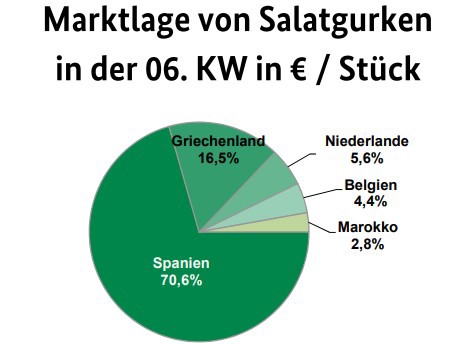Spanish cucumbers dominated the scene. They were complemented by Greek shipments. Shipments from the Netherlands, Belgium, and Morocco had increased, according to BLE. Overall, however, availability was limited due to poor weather conditions in the growing regions, so that interest could not be satisfied throughout. Consequently, prices knew only one direction: they went up, sometimes very strongly. Frankfurt reported prices of up to €1.79 per unit, and similar prices were seen in Berlin.

Customers also had to dig deeper into their pockets for mini cucumbers. The products from Turkey, Spain, and the Netherlands were sold continuously. In Frankfurt, they were complemented by the first Greek batches. Egyptian imports appeared in Berlin, costing €17 per 7 kg box. The first domestic items arrived in Munich, where they met with limited demand.
Apples
Domestic offerings continued to dominate the scene, with Elstar, Jonagold, Braeburn, and Boskoop forming the basis of supply. From Italy, Granny Smith, Pink Lady, and Golden Delicious were the main varieties. France participated mainly with the club varieties Pink Lady and Jazz.
Pears
As in previous weeks, Italian Abate Fetel, Santa Maria, and Williams Christ dominated sales. Turkish Santa Maria followed in terms of importance. The Netherlands sent Conference and Xenia, among others, and Belgium sent Conference exclusively. From Germany came Xenia, Alexander Lucas and Boscs Flaschenbirne.
Table grapes
South African shipments were clearly dominant. Shipments from Peru and Namibia played a much smaller role. A large number of varieties were available, which also still showed inconsistent quality. Accordingly, a very wide price range established itself on some markets.
Oranges
With regard to blond oranges, Spanish accessions dominated marketing with Navelina, Navel, Salustiana, Navelate, and Lane Late. From Türkiye, Washington Navel was the main source. Imports from Morocco, Egypt, and Greece rounded out the product range. The cold but sunny weather had improved the accommodations in some places, and customers were definitely digging in.
Small citrus fruits
Spanish mandarins, often Nadorcott and Clemenules, predominated. Israeli Orri followed in importance ahead of Turkish Murcott and Moroccan Nadorcott. There was usually a fairly friendly demand, which was met without problems despite a reduced availability.
Lemons
Spanish Primofiori dominated the scene, Turkish Lama complemented them and gained some market share. Italian and Greek goods appeared only sporadically. Supplies were sufficient to satisfy the demand.
Bananas
Business proceeded to be fairly quiet. The assortment had not changed significantly; meanwhile, third brands from Ecuador were missing in Cologne. Availability was generally sufficient to meet the demand. Nevertheless, prices often trended upward as sales improved.
Cauliflower
Italian batches obviously predominated. Spanish and French lots held more of a supplementary status. The high demands of the previous week continued or were even raised. Customers should pay up to €28,- per 6 in Frankfurt, for instance, for French goods.
Lettuce
In the case of iceberg lettuce, the first Turkish goods joined the dominant Spanish goods: they were cheaper than the European goods and could therefore be accommodated quickly in Berlin. Overall, the Spanish batches were not always sufficient to cover demand. Consequently, rising prices were not uncommon.
Tomatoes
Although a wide range was available, overall availability was limited. Difficult weather conditions in the growing regions and associated crop failures ensured a limited supply situation. In addition, the quality of the produce was not consistently convincing.
Sweet peppers
As in previous weeks, Spanish supplies dominated the market. Turkish imports supplemented it. In Frankfurt and Berlin, there were also red products from Morocco, and in Hamburg, yellow and red items from Israel. Availability was continuously tight, the bad weather in the production areas being the cause in most cases.
Source: BLE
